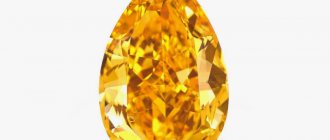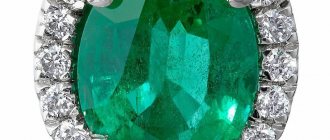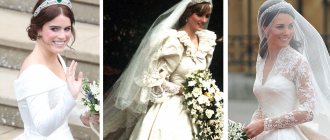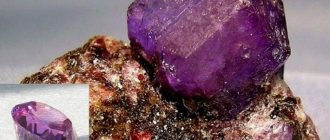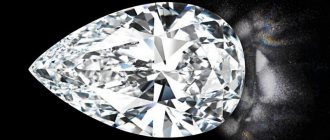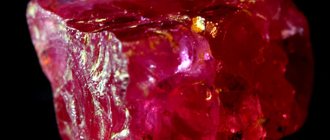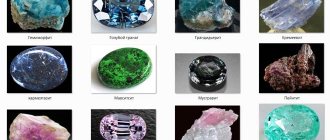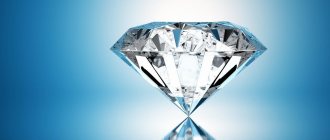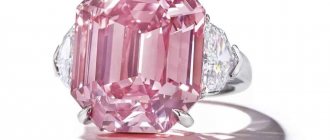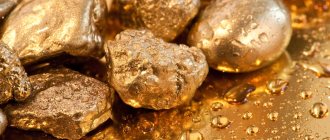These precious stones excite admiration not even for their value, but for the beauty of their form and purity. They receive their own names and are rightfully considered kings in the universe of stones. Some large stones are bought and sold, and the cost of such an acquisition is many times higher than their objective value, because each stone is unique and only very rich people can afford to own such beauty. There are also those that have never been put up for auction, they are in the possession of monarchs and from time to time are exhibited in museums so that people can enjoy their beauty.
Oppenheimer Blue Diamond
Oppenheimer Blue Diamond
One of the most expensive stones is the Oppenheimer Diamond, which costs $57.5 million . This bright blue stone, weighing 14.62 carats, belonged to Philip Oppenheimer, but was sold at auction in Geneva and was considered the most expensive diamond until 2022. The Gemological Institute of America estimates that only 1 percent of blue stones have this brightness.
Sample passport
The color of a diamond is one of the four criteria of the 4C system for assessing its quality and value, adopted in international practice. This characteristic directly depends on the chemical composition of the mineral and does not change over time. Because a diamond has no color, it allows more light to pass through it than a colored stone. Due to the peculiarities of diamond formation, only a few specimens are truly colorless.
When grading, it is believed that the less color, the better the quality of the diamond.
What colors are diamonds?
The most valuable diamonds are those that are completely colorless or have a tint of blue, as well as those with bright fancy colors - blue, pink, red, yellow, green, etc., but most mined diamonds have yellow, brown or sulfur shades of varying intensities. Conventionally, diamonds are divided into four types:
- colorless;
- with shades of different saturation;
- dyed: yellow with shades of different saturation, brown with shades of different saturation;
- with fantasy coloring.
International system for grading diamond color
Many jewelers use the GIA (Gemological Institute Of America) professional color chart. The color scale is divided into groups depending on how noticeable the color of the stone is, starting with stones that are completely colorless and then progressing as the hue increases in intensity to the final group, yellow-colored diamonds. Each group is designated by a letter of the Latin alphabet: from D - colorless stones to Z - light yellow or with a visible brown tint. Each letter in the scale corresponds to a specific spectrum of colors.
Assessing the color of a diamond comes down to determining the color group. The coloring of yellow and brown stones with a color characteristic below Z is considered fancy. For stones with fancy colors, there are their own color groups; when describing such stones, the word “fancy” is used, then the color and its intensity are described
To create a universal scale for grading diamonds by color, gemologists at the GIA Institute carefully selected a number of standard stones. To determine what color the diamonds being graded are, they are compared to reference stones.
*more details on the diamond sales page.
Russian assessment system
The national standard of the Russian Federation offers a similar approach, but numbers are used instead of letters for designation. The technical requirements used in the evaluation of diamonds are given in TU 117-4.2099-2002.
The classification includes groups from 1 - colorless diamonds to 9 - stones of the brown spectrum. Within groups 8 and 9 there are subgroups that describe the intensity of yellow and brown shades, respectively. Group 1 should also include diamonds of unique colors (pink, blue, emerald green, etc.).
The best
The most expensive diamond is red, with a blue stone slightly inferior in price. These same colors are included in the ranking of the rarest diamonds. Due to the fact that they are extremely rare in nature, but jewelry with them is in demand, stones of such shades are preferred to be grown in artificial conditions.
pink star
Pink Star Diamond
The Steimetz Pink Diamond or “Pink Star”, weighing 59.60 carats, is considered the largest stone of this color. It was found in 1999 at the De Beers mine and cut for 20 months, after which it was shown to the world in 2003 in Monaco, and in 2022 it was sold at auction for $71.2 million. The Pink Star diamond is currently worth $25 million .
The Heart of Eternity
The Heart of Eternity is a 27.64 carat (5.528 g) brilliant blue diamond. It is classified as an extremely rare class of colored diamonds. It was discovered in January 2000 in the same mine as the Allnutt diamond - Premier Mine, South Africa. Current owner is Said Qadri. Estimated cost : $16 million .
7
Centennial Diamond
De Beers Centennial Diamond
Stunning in its beauty and clarity, the Centennial Diamond, named in honor of the centenary of the De Beers Consolidated Mines organization, weighs 273.85 carats. The stone was found in the Primer mine and introduced to the world in 1998. The price of the stone is 100 million dollars , but the current location is not known for certain, since De Beers does not disclose information.
Diamond of Hope
The Hope Diamond The
“Hope Diamond” or “Hope Diamond” weighs 45.52 carats, is valued at $350 million and is currently housed in the Smithsonian Museum. It was found at the Kollur mine in India in the 17th century, and took its name from the surname Hope, which was borne by the banker who bought the stone in 1839. The peculiarity of a diamond is that when ultraviolet rays hit it, it changes its bright blue color to red; the reason for this phenomenon is the phosphorus contained in the stone. There is a legend according to which the "Hope Diamond" is cursed and extends the curse to its owners.
Diamond Cullinan
The Cullinan Diamond
The Cullinan Diamond, discovered at the Premier Mines in South Africa, weighs 3,106.75 carats. This stone is considered to be the largest gem-quality rough diamond ever found. The Cullinan Diamond is worth $400 million and is considered one of the most expensive stones in the world.
Sancy
The Sancy Diamond
The Sancy Diamond is a large light yellow stone, shaped like a shield with a flower inside; it was this stone that was the first to receive a symmetrical cut. It is believed that it was previously owned by the Mongols, but based on the shape of the stone, it can be assumed that it belonged to India. Over the course of its history, the diamond belonged to various rulers of France, and received its name from the lord de Sancy. In 1978, the diamond became the property of the Louvre, which bought the stone from Viscount Astor for $1 million . The value of Sancy is currently unknown.
Cullinan I
Cullinan I.
A stone of stunning purity and shape can be called the standard of jewelry art. It was part of a truly enormous Cullinan diamond, which, through cutting and cutting, became the basis for many smaller, but not a little impressive stones. In order to carry out this exquisite work, they invited the most skilled craftsman - Joseph Ascher, popular for his ability to “open” diamonds.
The jeweler spent more than two months studying the diamond and only after that was able to determine the very point at which a blow would split the stone along existing cracks and at the same time free it from inclusions. As a result, the largest fragment appeared - Cullinan I weighing 530.2 carats, which became an adornment of the Royal Scepter of the British Empire.
READ ALSO: Who will get the jewelry of Elizabeth II after her departure >>
Kohinoor
Kohinoor Diamond
The Kohinoor Diamond or Mountain of Light was discovered in the 14th century in India and has been owned by various rulers since then. It was once the largest stone, weighing 105.6 carats, but in 1852 Prince Albert had the stone reduced to 86 carats to increase its brilliance. There is a legend according to which Kohinoor carries a curse on the one to whom it belongs, and until 1849 the stone actually harmed its owners. Currently, Kohinoor belongs to the Tower of London, and the price of the stone has not been determined.
Commenting system SigComments
What can color and shade depend on?
There are several factors that influence the hue and color characteristics of beautiful and unique minerals.
- Firstly, these are natural factors. Beautiful and rare mineral samples lie in the depths of our planet and are formed over tens of thousands of years. Constant pressure, the influence of temperature changes, the depth of occurrence and the presence in the specimen itself and in its surroundings of impurities in the form of dust, fragments and other elements of other ores (for example, iron) add richness to the shade or can completely change the color of the diamond, while leaving the famous color for the whole the world is the hardness of a diamond.
- Secondly, the distance between the molecular compounds in the crystal lattice of the precious solid stone formation. If the distances between the elements are smaller, then the mineral looks more “saturated” in color.
- Thirdly, the purity of the diamond, and then the cut miracle - the diamond. The rarer the stone, the purer it is, the better its dispersion characteristics and the nature of the mineral better conveys shade and saturation with as few inclusions and defects as possible.
- Fourthly, this is the direct process of cutting, polishing, and polishing a rare, hard, beautiful diamond. Thanks to the skillful efforts of the jeweler, unnecessary parts are cut off, painstaking work is done, sometimes taking more than one week or more than one month.
The result is not only a beautiful and unique masterpiece, but also the most saturated color shade of the diamond.
- Fifthly, there are modern methods that help improve the color and shading qualities of jewelry.
One of them is the effect of high pressure and temperature on the product. In essence, this is an attempt to repeat the conditions that nature itself did, but in a much shorter period of time and affecting only the color factor, while leaving other parameters untouched. Naturally, this method is very popular and only affects the color change.
- Sixthly, another modern method is the exposure of a solid diamond specimen to radioactive radiation. The action takes place in a nuclear reactor. When radioactive particles pass through a mineral, they interact with the molecules of the crystal and a subsequent reaction, which is enhanced or reduced only by the color saturation up or down to the required level.
After such exposure, the sample does not become radioactive, so there is no need to be afraid that it will pose a threat and danger. After this procedure, it is carefully checked in laboratory conditions for the absence of radiation.
